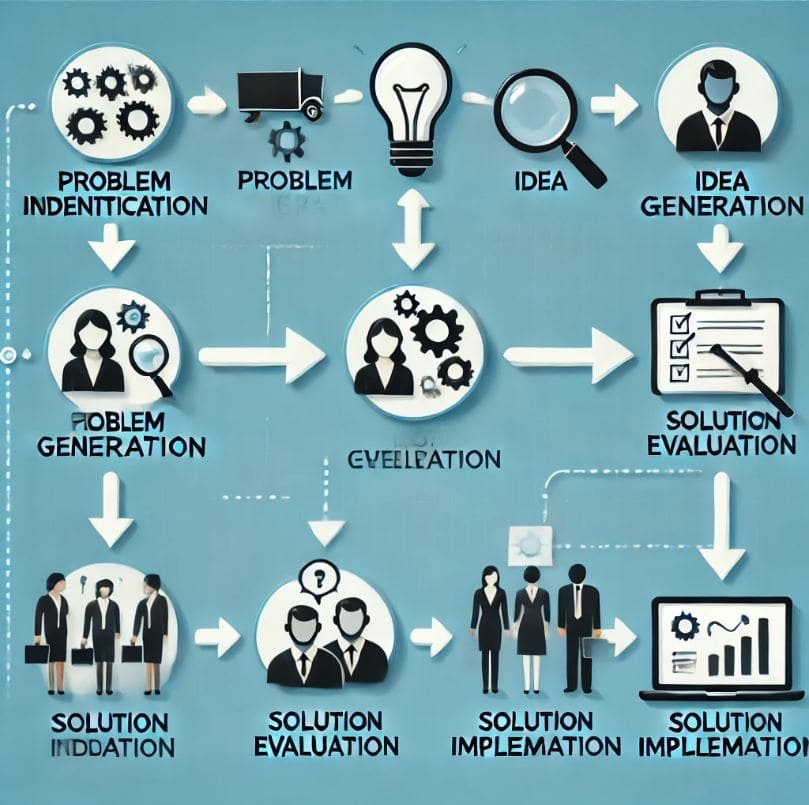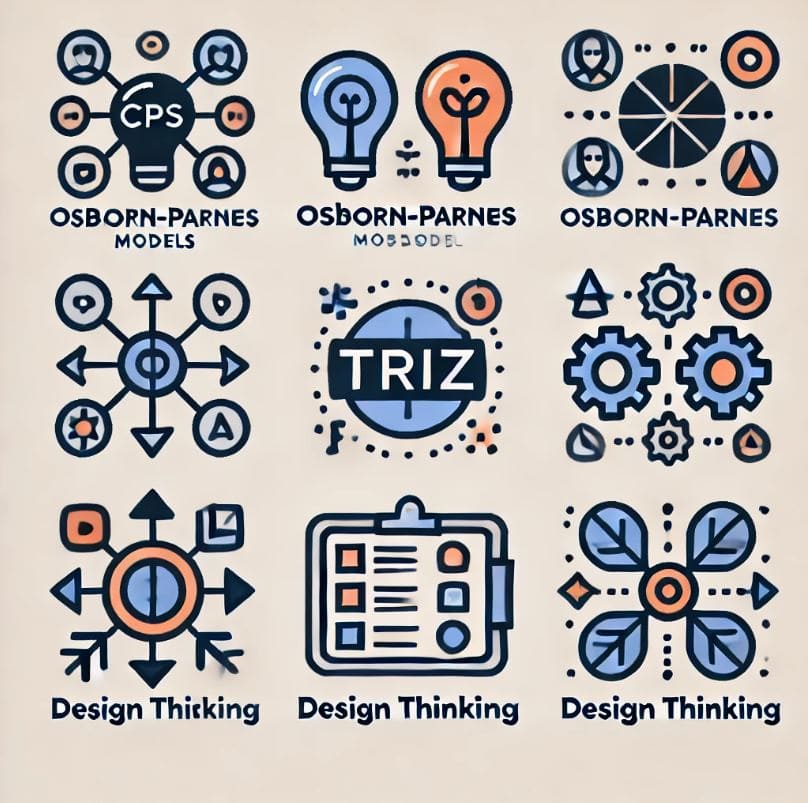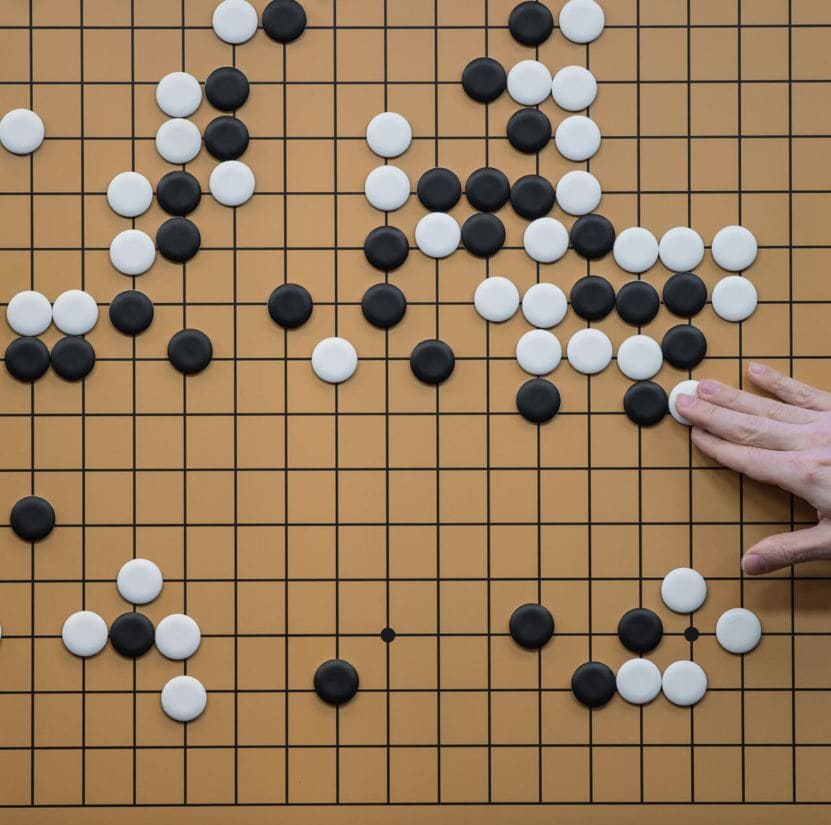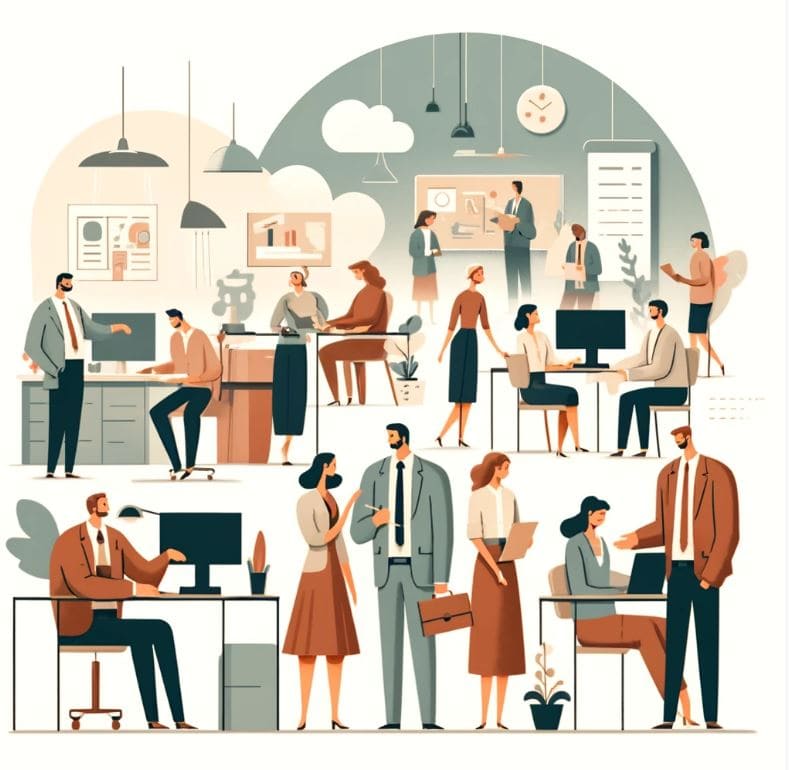Unlocking Creativity: Mastering Creative Problem Solving with Insights from the Game of Go


In today’s world, where innovation is paramount, mastering the art of creative problem solving has become more crucial than ever. Whether tackling personal challenges or seeking breakthroughs in one’s professional career, the capacity for creative thinking can set individuals apart. This article examines various methods and frameworks for creative problem solving, drawing inspiration from a diverse range of fields. Additionally, we delve into the age-old game of Go (known as Baduk in Korea and Weiqi in China) to uncover timeless strategies that can enhance one’s creative thinking abilities.
What is Creative Problem Solving?

Creative problem solving (CPS) is a method that involves approaching a problem or challenge from an innovative and imaginative perspective. It utilizes various techniques to generate solutions that may not be immediately apparent, encouraging a more lateral and unconventional approach.
The Importance of Creative Problem Solving
In today’s rapidly changing world, the ability to creatively solve problems is essential for both personal and professional success. CPS can lead to more efficient and innovative solutions, driving growth and providing a competitive advantage.
Key Facts and Figures:
- Definition and Importance:
- Creative problem solving is essential in navigating complex challenges and finding innovative solutions (Harvard Business School, 2021).
- It emphasizes the importance of creativity in overcoming various challenges, improving decision-making, and strategic planning..
- Techniques for CPS:
- Brainstorming: Encourages idea generation without criticism.
- Mind Mapping: Visualizes ideas and their connections to explore different aspects of a problem.
- SCAMPER: Stands for Substitute, Combine, Adapt, Modify, Put to another use, Eliminate, and Reverse to explore new solutions.
- Six Thinking Hats: Uses different perspectives for comprehensive problem-solving.
- CPS Processes:
- Clarify the Problem: Accurately identify and define the problem.
- Generate Ideas: Use brainstorming and other methods for idea generation.
- Develop Solutions: Evaluate and refine potential solutions.
- Implement Solutions: Effectively implement and evaluate the solutions.
- Applications and Benefits:
- CPS is used in various fields such as business, education, and healthcare to foster innovation and drive success (Creative Education Foundation, 2021).
- Companies that encourage CPS are more likely to outperform their competitors by up to 50% (MindTools, 2021).
- Real-World Examples:
- Google: Uses brainstorming sessions to innovate products and services.
- Apple: Employs mind mapping in the design process to visualize and connect ideas.
CPS Techniques and Their Uses
| Technique | Description | Use Case |
| Brainstorming | Generating ideas without criticism | Product development sessions |
| Mind Mapping | Visualizing ideas and their connections | Strategic planning |
| SCAMPER | Exploring different aspects of a problem | Marketing strategy development |
| Six Thinking Hats | Using different perspectives | Team decision-making processes |
Creative problem solving not only promotes innovation, but also equips individuals and organizations with the necessary skills to navigate and succeed in a constantly changing world. By incorporating these techniques and processes, one can unlock new possibilities and achieve success in various fields.
Key Steps in the Creative Problem-Solving Process

The CPS process typically involves several steps that guide individuals from problem identification to solution implementation. These steps include:
Identifying the Problem
Clearly defining the problem is a crucial first step in the creative problem-solving process. This involves an in-depth understanding of the issue and a clear definition of the desired outcome. Harvard Business School emphasizes that accurate identification of the problem ensures that efforts are focused on the right challenge and avoids wasted resources and time.
Key Activities in Problem Identification:
- Conducting a thorough analysis of the problem context.
- Engaging stakeholders to gather diverse perspectives.
- Using tools like the “Five Whys” to drill down to the root cause.
Generating Ideas
This stage focuses on generating ideas and exploring a diverse range of potential solutions. Techniques such as mind mapping, SCAMPER (a technique for generating ideas by changing aspects of a product or service), and brainwriting can be useful here. MindTools emphasizes that brainstorming sessions should be conducted in a non-judgmental environment to create a safe space for creative thinking.
Effective Techniques for Idea Generation:
- Mind Mapping: Visualize ideas and their connections.
- SCAMPER: Substitute, Combine, Adapt, Modify, Put to another use, Eliminate, and Reverse.
- Brainwriting: Silent idea generation to allow individual thinking before group discussion.
Evaluating and Selecting Solutions
Once a variety of ideas have been generated, the next step is to evaluate them based on feasibility, impact, and alignment with goals. This helps in selecting the most promising solution. According to the Creative Education Foundation, criteria for evaluation should be clearly defined to facilitate objective decision-making.
Steps in Solution Evaluation:
- Develop criteria for evaluating ideas (e.g., cost, impact, feasibility).
- Use tools like SWOT analysis (Strengths, Weaknesses, Opportunities, Threats).
- Rank ideas and select the top candidates for further development.
Implementing the Solution
After selecting the best course of action, the next step is to create an action plan and implement it. In order to ensure successful implementation, it is necessary to monitor and adjust the plan as required. According to the Coursera methodology, this stage involves setting clear objectives, assigning responsibilities, and creating a timeline.
Key Components of Solution Implementation:
- Action Plan: Outline tasks, timelines, and responsibilities.
- Monitoring Progress: Track milestones and adjust plans as necessary.
- Evaluation: Measure the impact of the solution and iterate if needed.
Summary Table of CPS Process
| Step | Key Activities | Tools and Techniques |
| Identifying the Problem | Analyzing context, stakeholder engagement, root cause analysis | Five Whys, Fishbone Diagram |
| Generating Ideas | Brainstorming, silent idea generation, exploring different angles | Mind Mapping, SCAMPER, Brainwriting |
| Evaluating Solutions | Defining evaluation criteria, SWOT analysis, ranking ideas | SWOT Analysis, Decision Matrix |
| Implementing Solutions | Developing action plan, monitoring progress, adjusting as needed | Gantt Charts, Key Performance Indicators |
Real-World Applications
Creative problem-solving is a widely used technique in various industries to promote innovation and address complex challenges. Companies such as Google utilize brainstorming sessions to drive product development, while Apple’s design process relies heavily on mind mapping techniques to visualize and organize ideas.
In summary, mastering the process of creative problem-solving can significantly enhance both personal and organizational abilities to address complex challenges. Through the systematic identification of problems, generation of diverse ideas, objective evaluation of solutions, and effective implementation, individuals and teams can achieve new levels of innovation and success.
Models and Techniques of Creative Problem Solving

Several models and techniques can enhance the CPS process, including:
The Osborn-Parnes Creative Problem-Solving Process
This model, developed by Alex Osborn and Sidney Parnes, emphasizes divergent and convergent thinking through a series of stages, including fact-finding, problem identification, idea generation, solution development, and acceptance. This process systematically guides individuals through the process of identifying problems and finding solutions, leading to innovative and practical results.
Steps of the Osborn-Parnes CPS Process:
- Fact-Finding: Identify and gather relevant information about the problem.
- Problem-Finding: Define the problem clearly.
- Idea-Finding: Generate a wide range of potential solutions.
- Solution-Finding: Evaluate and refine the ideas to find the best solution.
- Acceptance-Finding: Develop an action plan to implement the solution.
TRIZ (Theory of Inventive Problem Solving)
TRIZ is a systematic methodology that draws on patterns of problem-solving, encouraging innovative thinking based on prior knowledge. It involves identifying the root cause of a problem and applying a variety of principles to resolve it. TRIZ emphasizes overcoming contradictions in a non-compromising manner and utilizes a vast repository of known solutions as a source of inspiration for novel ideas.
Key Components of TRIZ:
- Contradiction Matrix: Resolves conflicting requirements.
- 40 Inventive Principles: Offers strategies to overcome challenges.
- Ideal Final Result: Defines the perfect outcome without limitations.
Design Thinking
This user-centered approach is based on empathy, problem definition, idea generation, prototyping, and testing, which are commonly used in product development and innovation processes. Design thinking is an iterative process that emphasizes understanding user needs in order to develop effective solutions.
Phases of Design Thinking:
- Empathize: Understand the user’s needs and experiences.
- Define: Clearly articulate the problem to be solved.
- Ideate: Brainstorm a range of ideas and solutions.
- Prototype: Create tangible representations for a subset of ideas.
- Test: Evaluate the prototypes and refine the solutions based on feedback.
Comparison of CPS Models
| Model | Focus | Key Techniques |
| Osborn-Parnes CPS | Divergent and convergent thinking in structured stages | Brainstorming, fact-finding, idea-finding |
| TRIZ | Systematic innovation based on patterns of problems/solutions | Contradiction Matrix, Inventive Principles |
| Design Thinking | User-centered, iterative process | Empathy, prototyping, testing |
These models and techniques offer structured and effective ways to approach creative problem solving, allowing individuals and organizations to navigate complex challenges and develop innovative solutions. Whether it’s through the systematic stages of the Osborn-Parnes CPS process, the inventive principles of TRIZ, or the user-focused iterations of Design Thinking, each model provides valuable tools to enhance creative problem-solving capabilities.
By incorporating these models into your workflow, you can ensure a comprehensive and effective approach to tackling problems, driving innovation, and achieving successful outcomes.
Enhancing CPS Skills in the Workplace

Creative problem-solving is highly valued within professional settings. To foster these skills in the workplace, several strategies can be employed:
Encouraging a Culture of Innovation
Creating an environment that encourages and rewards creative thinking can encourage employees to approach challenges with fresh perspectives. The Harvard Business School suggests that fostering an innovative culture involves creating an atmosphere in which employees feel safe taking risks and experimenting without fear of failure. Such a culture promotes continuous learning and flexibility, which are essential for the success of CPS..
Strategies to Encourage Innovation:
- Recognition and Rewards: Acknowledge and reward innovative ideas and solutions.
- Open Communication: Encourage open dialogue where employees can share ideas freely.
- Flexible Work Environment: Provide a workspace that supports collaboration and creativity.
Providing Training and Resources
Providing workshops, tools, and resources can equip employees with the necessary skills to engage in effective CPS (Customer Relationship Management). MindTools emphasizes the significance of structured training programs that encompass different CPS techniques and methodologies..
Effective Training Approaches:
- Workshops and Seminars: Regular sessions focused on CPS techniques such as brainstorming, SCAMPER, and mind mapping.
- Online Courses: Provide access to online platforms like Coursera and LinkedIn Learning for self-paced learning.
- Resource Libraries: Maintain a collection of books, articles, and case studies on CPS.
Promoting Collaboration
Encouraging teamwork and diversity of opinion can lead to stronger and more innovative solutions. The Creative Education Foundation argues that collaboration enhances the CPS process by bringing together diverse perspectives and expertise, leading to more creative solutions.
Ways to Promote Collaboration:
- Cross-Functional Teams: Create teams with members from different departments to tackle problems.
- Collaborative Tools: Use digital tools like Slack, Trello, and Miro to facilitate collaboration.
- Team-Building Activities: Organize activities that build trust and improve teamwork skills.
Impact of CPS in the Workplace
- Increased Innovation: Companies that prioritize CPS see a significant increase in innovative ideas and solutions. For example, Google’s culture of continuous innovation has led to the development of breakthrough products such as Gmail and Google Maps.
- Improved Problem-Solving: Teams equipped with CPS skills can address challenges more effectively, leading to better decision-making and outcomes.
- Enhanced Employee Engagement: A workplace that promotes creativity and teamwork is likely to have higher levels of employee satisfaction and commitment..
By encouraging By encouraging a culture of innovation, providing the necessary training and resources, and promoting collaboration, organizations can significantly enhance their creative problem-solving capabilities. These strategies not only lead to better problem-solving outcomes but also foster a more dynamic and engaging workplace environment.
Lessons from Go: Enhancing Creative Problem Solving

The game of Go, with its deep strategic elements, offers valuable insights into creative problem solving. Here are some lessons from Go that can be applied to CPS:
Strategic Planning and Flexibility
Go requires players to anticipate and adjust their strategies as the game progresses. This reflects the need for adaptability and strategic thinking in problem-solving. The Harvard Business School emphasizes that effective problem-solving involves not only planning but also adjusting strategies in response to new information and evolving circumstances.
Key Points in Strategic Planning and Flexibility:
- Long-Term Thinking: Players must plan several moves ahead, considering potential responses from their opponent.
- Adaptability: Flexibility to change plans when the opponent makes unexpected moves.
Pattern Recognition
Success in Go requires recognizing patterns and predicting opponents’ moves, which is similar to the benefits of CPS in identifying trends and potential challenges early on. MindTools stresses the significance of pattern recognition for brainstorming and evaluating ideas, as this helps identify viable solutions more efficiently.
Benefits of Pattern Recognition:
- Efficiency: Quickly identify useful patterns and discard ineffective ones.
- Predictive Power: Anticipate potential challenges and opportunities.
Patience and Perseverance
Go teaches the importance of patience and perseverance in overcoming challenges. These attributes are essential for maintaining creative efforts and finding solutions to problems. The Creative Education Foundation emphasizes that perseverance is crucial in the iterative process of creative problem-solving, where initial attempts may fail, but continued effort can lead to successful outcomes.
Qualities of Patience and Perseverance:
- Resilience: Continuously refining ideas despite setbacks.
- Commitment: Staying focused on the end goal even when immediate results are not visible.
Enhance your creative problem-solving skills through the strategic and analytical lessons offered by the game of Go. At GoMagic, you can dive deeper into the world of Go and leverage its principles to boost your problem-solving abilities:
- Learn How to Play Go: Understand the rules and fundamentals of Go at GoMagic Rules.
- Solve Go Problems: Increase your level of play and sharpen your strategic thinking with interactive Go problems at GoMagic Problems.
- Video Courses: Access video courses with interactive elements for players of all levels at GoMagic Courses.
By integrating these insights from Go into your creative problem-solving approach, you can improve your strategic planning skills, enhance your ability to recognize patterns, and develop the necessary patience and persistence to see innovative solutions to fruition.
Explore more about the game of Go and how it can improve your problem-solving skills at GoMagic.
Conclusion
Creative problem-solving is a crucial skill that can lead to innovation and success in various aspects of life. By applying proven methods and drawing inspiration from the game of Go, individuals can improve their ability to develop and implement effective solutions. Adopting the strategies discussed in this article will help unlock your creative potential and allow you to tackle challenges with confidence and ingenuity.





Leave a comment